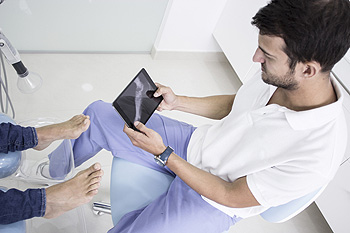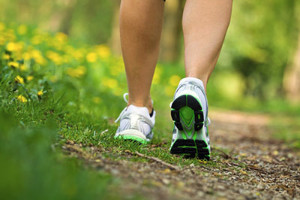Items filtered by date: January 2022
What Is a Bunionette?
Many people have seen, or experienced, a bunion on the big toe. But a less common type of bunion, which can form at the base of the little toe, is often referred to as a bunionette. It can be very painful, especially if it frequently rubs against a tight-fitting shoe. A bunionette usually occurs when the metatarsal bone of the midfoot angles outward and the little toe points inward and becomes deformed at its base. Simple treatments are often successful, such as wearing shoes with a wider toe box, using a toe spacer between the 4th and 5th toe, or simply padding the area to reduce irritation from your shoes. It may also help to do less standing or walking. If these measures fail to bring relief and the pain from a bunionette increases, it is best to consult a podiatrist who can X-ray your foot and offer a treatment plan that is appropriate.
If you are suffering from bunion pain, contact Dr. John P. Beaupied of Palos Podiatry. Our doctor can provide the care you need to keep you pain-free and on your feet.
What Is a Bunion?
Bunions are painful bony bumps that usually develop on the inside of the foot at the joint of the big toe. As the deformity increases over time, it may become painful to walk and wear shoes. Women are more likely to exacerbate existing bunions since they often wear tight, narrow shoes that shift their toes together. Bunion pain can be relieved by wearing wider shoes with enough room for the toes.
Causes
- Genetics – some people inherit feet that are more prone to bunion development
- Inflammatory Conditions - rheumatoid arthritis and polio may cause bunion development
Symptoms
- Redness and inflammation
- Pain and tenderness
- Callus or corns on the bump
- Restricted motion in the big toe
In order to diagnose your bunion, your podiatrist may ask about your medical history, symptoms, and general health. Your doctor might also order an x-ray to take a closer look at your feet. Nonsurgical treatment options include orthotics, padding, icing, changes in footwear, and medication. If nonsurgical treatments don’t alleviate your bunion pain, surgery may be necessary.
If you have any questions, please feel free to contact our office located in Palos Heights, IL . We offer the newest diagnostic and treatment technologies for all your foot care needs.
How a Podiatrist Can Help You
 Podiatrists are medical doctors who focus on treating issues with the lower legs, ankles and feet. They can do surgery, reset bones that are broken, and write prescriptions. Podiatrists are also helpful for diabetic patients because diabetes can prevent them from getting enough blood to the feet. Because of this, regular podiatrist visits can help to prevent severe issues and even amputation. Podiatrists can help patients with a variety of foot related issues, such as heel pain, warts, calluses, ingrown toenails, fungal nail infections, and even athlete’s foot. Podiatrists can also treat injuries to the foot and ankles, including sports injuries like sprains. Patients who have any issues with their feet would be wise to consult with a podiatrist for a proper diagnosis and treatment method.
Podiatrists are medical doctors who focus on treating issues with the lower legs, ankles and feet. They can do surgery, reset bones that are broken, and write prescriptions. Podiatrists are also helpful for diabetic patients because diabetes can prevent them from getting enough blood to the feet. Because of this, regular podiatrist visits can help to prevent severe issues and even amputation. Podiatrists can help patients with a variety of foot related issues, such as heel pain, warts, calluses, ingrown toenails, fungal nail infections, and even athlete’s foot. Podiatrists can also treat injuries to the foot and ankles, including sports injuries like sprains. Patients who have any issues with their feet would be wise to consult with a podiatrist for a proper diagnosis and treatment method.
If you are experiencing pain in the feet or ankles, don’t join the stubborn majority refusing treatment. Feel free to contact Dr. John P. Beaupied from Palos Podiatry. Our doctor can provide the care you need to keep you pain-free and on your feet.
What Is a Podiatrist?
Someone would seek the care of a podiatrist if they have suffered a foot injury or have common foot ailments such as heal spurs, bunions, arch problems, deformities, ingrown toenails, corns, foot and ankle problems, etc.
Podiatric Treatment
A podiatrist will treat the problematic areas of the feet, ankle or lower leg by prescribing the following:
- Physical therapy
- Drugs
- Orthotic inserts or soles
- Surgery on lower extremity fractures
A common podiatric procedure a podiatrist will use is a scanner or force plate which will allow the podiatrist to know the designs of orthotics. Patients are then told to follow a series of tasks to complete the treatment. The computer will scan the foot a see which areas show weight distribution and pressure points. The podiatrist will read the analysis and then determine which treatment plans are available.
If you have any questions please feel free to contact our office located in Palos Heights, IL . We offer the newest diagnostic and treatment technologies for all your foot and ankle needs.
Can Running Shoes Be Worn for Walking?
Shoes made for walking are usually different from those designed for runners because the mechanics of each activity are different and require shoes that meet those needs. The main difference between walking and running is that when you run, there is a moment when both feet are off the ground. When you walk, one foot is always on the ground. The shift from one foot to the other is gradual, and your weight is transferred from heel to toe much more slowly. Here are some things to look for when searching for a running shoe that you can walk in. It might be a good idea to choose a shoe with a beveled, or angled heel to help with smoother landings. The outsole should have as much ground contact as possible and because the foot bends more in walking, look for a shoe with a flexible forefoot area. Also, try to find a shoe with ample cushioning in the forefoot, but guard against too much cushioning which can tire the feet more easily when walking. If you are unsure of what shoe is best for your feet, please contact a podiatrist for recommendations.
If you are a runner, wearing the right running shoe is essential. For more information, contact Dr. John P. Beaupied from Palos Podiatry. Our doctor can provide the care you need to keep you pain-free and on your feet.
Choosing the Right Running Shoe for Your Foot Type
To increase performance and avoid the risk of injury, it is important to choose the right running shoe based on your foot type. The general design of running shoes revolves around pronation, which is how the ankle rolls from outside to inside when the foot strikes the ground.
- Neutral runners are able to choose from a wide variety of shoes, including minimalist shoes or even going barefoot.
- Runners who overpronate, or experience an over-abundance of ankle rolling, should choose shoes that provide extra motion control and stability.
- Runners who underpronate, or supinate, have feet that have high arches and lack flexibility, preventing shock absorption. They require shoes with more flexibility and cushion.
If you have any questions please feel free to contact our office located in Palos Heights, IL . We offer the newest diagnostic and treatment technologies for all your foot and ankle needs.
Why Live with Pain and Numbness in Your Feet?
How to Reduce Foot Swelling During Pregnancy
Many women experience swelling in the feet and ankles during pregnancy. This common condition is known as edema, where fluids are trapped in the tissues of the body causing puffiness and swelling under the skin. Edema is more likely to occur in the late afternoon and evening after you have spent the day on your feet. Swollen feet and ankles may be more likely after the fifth month of pregnancy as weight gain continues and water retention increases. There are a few things that can help to alleviate swelling during your pregnancy. Try to avoid standing for long periods and keep your feet elevated while resting. Further, you can opt for comfortable shoes rather than high heels, and wear compression socks or tights. In addition, try to drink more water and cut back on salty foods. While resting, apply a cold compress to the swollen areas. If the swelling becomes serious, please make an appointment with a podiatrist for further examination and information on various treatment methods.
Pregnant women with swollen feet can be treated with a variety of different methods that are readily available. For more information about other cures for swollen feet during pregnancy, consult with Dr. John P. Beaupied from Palos Podiatry. Our doctor will attend to all of your foot and ankle needs.
What Foot Problems Can Arise During Pregnancy?
One problem that can occur is overpronation, which occurs when the arch of the foot flattens and tends to roll inward. This can cause pain and discomfort in your heels while you’re walking or even just standing up, trying to support your baby.
Another problem is edema, or swelling in the extremities. This often affects the feet during pregnancy but tends to occur in the later stages.
How Can I Keep My Feet Healthy During Pregnancy?
- Wearing orthotics can provide extra support for the feet and help distribute weight evenly
- Minimize the amount of time spent walking barefoot
- Wear shoes with good arch support
- Wear shoes that allow for good circulation to the feet
- Elevate feet if you experience swelling
- Massage your feet
- Get regular, light exercise, such as walking, to promote blood circulation to the feet
If you have any questions please feel free to contact our office located in Palos Heights, IL . We offer the newest diagnostic and treatment technologies for all your foot and ankle needs.







